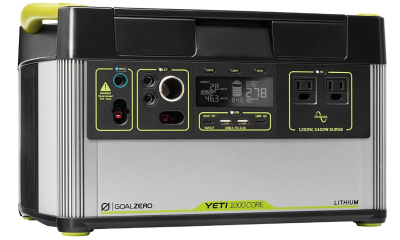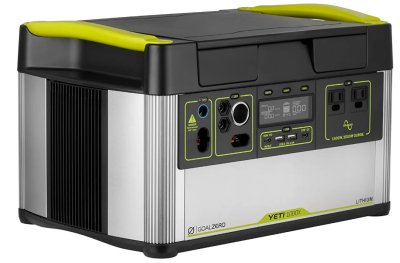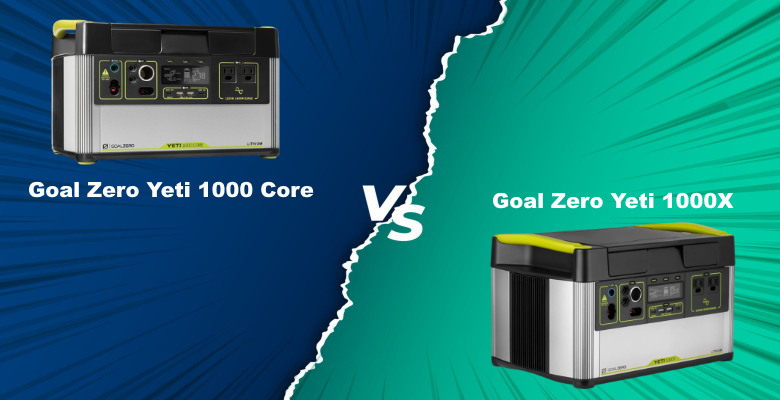The Goal Zero Yeti 1000 line of power stations are a great way for anyone to recharge and run devices when they can’t access an outlet. With their high power capacity and durable, portable design, they offer the ideal balance of performance and convenience, whether you plan to use it every day or just have it around for an emergency.
At first glance, it can be tricky to tell the difference between the Goal Zero Yeti 1000 Core vs 1000X, and the truth is they do offer very similar features and performance. Overall, the Yeti 1000X is the better power station (>>> Check on Amazon), with more power and a faster potential recharge time. However, the lower price of the Yeti 1000 Core makes it a fantastic value. Check out the full side-by-side below to decide which one is the best for you.
Goal Zero Yeti 1000 Core vs 1000X Side by Side:
| Goal Zero Yeti 1000 Core | Goal Zero Yeti 1000X | |
|---|---|---|
 |  |
|
| Continuous load | 1,200W | 1,500W |
| Voltage | 120V | 120V |
| Capacity | 983Wh | 983Wh |
| Item Weight | 31.7lbs | 31.7lbs |
| Item Dimensions | 15.25” X 10.2” X 9.9” | 18.1” X 13.1” X 12.7” |
| Price | Check on Amazon | Check on Amazon |
Recharging Speed
The Goal Zero Yeti 1000 Core has faster recharge time potential than the average power station. It can accept a solar array up to 300 watts, or up to 230 watts of power through its high-speed charge port. That means as little as 4-5 hours to fully recharge the power station.
While this is impressive, the Goal Zero Yeti 1000X is even more so. It can accept up to 600 watts through either a solar array or outlet, dropping its recharging time as low as 2 hours, the lowest you’re likely to find from this size of power station.
Faster recharge time: Goal Zero Yeti 1000X
Power Load
The battery capacity of the Yeti 1000 Core and 1000X are the same. The difference here is in how much power each can output. The Yeti 1000 Core maxes out at 1,200 continuous watts, or 2,400 surge watts. With the Yeti 1000X, that’s bumped up to 1,500 continuous watts or 3,000 surge watts.
Higher power output: Goal Zero Yeti 1000X
Value
The MSRP of the Yeti 1000 Core is a few hundred dollars lower than that of the Yeti 1000X. If you don’t absolutely need the higher capacity or faster charging time of the 1000X, you can save yourself quite a bit by going with the 1000 Core, which offers very impressive performance at the price.
Better value: Goal Zero Yeti 1000 Core
Goal Zero Yeti 1000 Core

The Goal Zero Yeti 1000 Core is one of the most versatile portable power stations you’ll find. With 1,200W of continuous pure sine wave power and a high capacity to match, it can run even power-hungry kitchen appliances and power tools. It can run a full-sized refrigerator for about 18 hours on a single charge, making it a great choice for emergency preparedness. Travelers will appreciate the variety of charging ports, with 10 that can be used simultaneously, including a fast-charge USB-C for Apple devices.
All of that power is packed into a relatively compact package. At just over 30 pounds, it’s a bit heavy to carry long distances or take on wilderness hikes, but it’s plenty small enough to take along in your car trunk, RV, or camping gear. The heavy-duty anodized aluminum housing and sealed internal battery make it road-worthy, too, and you can safely use it outdoors, on job sites, or anywhere else you want to take it.
You can recharge the Goal Zero Yeti 1000 Core fairly quickly, too. Its solar recharging speed is especially impressive, reaching a full charge in as little as 4 hours in good sun conditions through a 300-watt solar array. The 230W fast recharging option cuts the recharging time through a wall outlet down to about 5 hours, though it will take about twice as long just using a standard AC outlet without this option. It’s also easy to check in on the status of the battery and remaining charge on the front display, which can be toggled off to save power and lights up so you can still read it in the dark. Click here for our more in-depth Goal Zero Yeti 1000 Core review.
Pros
- Relatively compact and portable
- High enough output to run heavy-duty tools and appliances
- Simultaneously charge up to 10 devices
- 3 recharging options (solar panel, wall outlet, or car outlet)
- Fast recharging through solar or AC power
Cons
- Lower continuous power than the 1000X
Goal Zero Yeti 1000X

The Goal Zero Yeti 1000X shares a lot of the strengths of the 1000 Core. It has a similar light-up display and array of input options on the front panel and uses a similarly rugged aluminum housing and internal design. While it’s a smidge larger, it weighs the same and is equally portable to the Yeti 1000 Core.
The first difference with the Goal Zero Yeti 1000X is power. It has the same capacity as the 1000 Core but has a higher continuous pure sine wave output, up to 1,500 watts. This means you can use it to run more devices for longer—you won’t need to unplug the fridge to use the microwave or coffee maker, for example, and can keep both the grill and the cooler on at your tailgate without a problem.
The other major upgrade on the Yeti 1000X is its 600-watt high power charge port. Using this, you can charge it from empty to full in as little as 2 hours. This makes it ideal for professionals like contractors, who can quickly fill it up between jobs and get back to work faster. You can also use a solar array up to 600 watts to recharge it in 2-4 hours in the right sun conditions.
Pros
- Excellent power to weight ratio
- Simultaneously charge up to 10 devices (1,500W total capacity)
- Portable and durable design
- Multiple recharging options
- Recharges in as little as 2 hours
Cons
- Higher cost
- Slightly larger
Goal Zero Yeti 1000 Core vs 1000X: Which Is Better?
If money is no object, the Goal Zero Yeti 1000X will give you a bit more power and the option of recharging in about half the time (>>> Find the current price on Amazon). On the other hand, the power you’ll get from the Yeti 1000 Core will be plenty for most, and at a price that’s kinder on your wallet.
